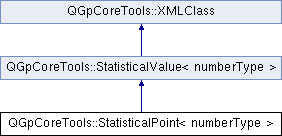
Brief description of class still missing. More...
#include <StatisticalPoint.h>

Public Member Functions | |
| bool | fromString (const StringSection &str) |
| void | interpole (double valX, const StatisticalPoint< numberType > &p1, const StatisticalPoint< numberType > &p2) |
| bool | operator< (const StatisticalPoint< numberType > &p) const |
| void | operator= (const StatisticalPoint< numberType > &o) |
| void | operator= (const StatisticalValue< numberType > &o) |
| bool | operator== (const StatisticalPoint< numberType > &p) const |
| void | setX (double v) |
| StatisticalPoint () | |
| StatisticalPoint (double x, const numberType &y) | |
| QString | toString (int precision=6, char format='g') const |
| double | x () const |
Protected Member Functions | |
| XMLMember | xml_member (XML_MEMBER_ARGS) |
| bool | xml_setProperty (XML_SETPROPERTY_ARGS) |
| void | xml_writeProperties (XML_WRITEPROPERTIES_ARGS) const |
Brief description of class still missing.
Full description of class still missing
| QGpCoreTools::StatisticalPoint< numberType >::StatisticalPoint | ( | ) | [inline] |
Description of constructor still missing
{}
| QGpCoreTools::StatisticalPoint< numberType >::StatisticalPoint | ( | double | x, |
| const numberType & | y | ||
| ) | [inline] |
: StatisticalValue<numberType>(y), _x(x) {}
| bool QGpCoreTools::StatisticalPoint< numberType >::fromString | ( | const StringSection & | str | ) |
References QGpCoreTools::StringSection::isValid(), QGpCoreTools::StringSection::nextField(), QGpCoreTools::StringSection::nextNumber(), QGpCoreTools::StatisticalValue< numberType >::setMean(), QGpCoreTools::StatisticalValue< numberType >::setValid(), QGpCoreTools::StatisticalValue< numberType >::setWeight(), QGpCoreTools::StringSection::toDouble(), TRACE, and w.
{
TRACE;
const QChar * ptr=0;
StringSection f;
f=str.nextField(ptr);
if(f.isValid()) _x=f.toDouble(); else return false;
numberType tmp;
if(str.nextNumber(tmp, ptr)) {
StatisticalValue<numberType>::setMean(tmp);
} else return false;
f=str.nextField(ptr);
if(f.isValid()) StatisticalValue<numberType>::setStddev(f.toDouble()); else return false;
f=str.nextField(ptr);
if(f.isValid()) {
double w=f.toDouble();
if(w==0.0) {
StatisticalValue<numberType>::setValid(false);
StatisticalValue<numberType>::setWeight(1.0);
} else {
StatisticalValue<numberType>::setValid(true);
StatisticalValue<numberType>::setWeight(w);
}
} else return false;
return true;
}
| void QGpCoreTools::StatisticalPoint< numberType >::interpole | ( | double | valX, |
| const StatisticalPoint< numberType > & | p1, | ||
| const StatisticalPoint< numberType > & | p2 | ||
| ) | [inline] |
| bool QGpCoreTools::StatisticalPoint< numberType >::operator< | ( | const StatisticalPoint< numberType > & | p | ) | const [inline] |
References QGpCoreTools::StatisticalValue< numberType >::mean().
{
return _x < p._x || (_x==p._x && StatisticalValue<numberType>::mean()<p.mean());
}
| void QGpCoreTools::StatisticalPoint< numberType >::operator= | ( | const StatisticalPoint< numberType > & | o | ) | [inline] |
Reimplemented in QGpCoreWave::FactoryPoint.
References QGpCoreTools::StatisticalValue< numberType >::operator=(), and TRACE.
{
TRACE;
StatisticalValue<numberType>::operator=(o);
_x=o._x;
}
| void QGpCoreTools::StatisticalPoint< numberType >::operator= | ( | const StatisticalValue< numberType > & | o | ) | [inline] |
Reimplemented from QGpCoreTools::StatisticalValue< numberType >.
References QGpCoreTools::StatisticalValue< numberType >::operator=(), and TRACE.
| bool QGpCoreTools::StatisticalPoint< numberType >::operator== | ( | const StatisticalPoint< numberType > & | p | ) | const [inline] |
References QGpCoreTools::StatisticalValue< numberType >::operator==().
{
return _x==p._x && StatisticalValue<numberType>::operator==(p);
}
| void QGpCoreTools::StatisticalPoint< numberType >::setX | ( | double | v | ) | [inline] |
Referenced by QGpCoreWave::MagnetoTelluricFactory::curve(), Histogram2D::meanCurve(), Histogram2D::medianCurve(), Histogram2D::modeCurve(), QGpGuiWave::DispersionProxy::parse(), QGpGuiWave::AutocorrProxy::parse(), QGpGuiWave::EllipticityProxy::parse(), SciFigs::ComplexStatisticalProxy::parse(), SciFigs::RealStatisticalProxy::parse(), QGpGuiWave::RefractionProxy::parse(), SPACLoopTask::run(), QGpGuiWave::EllipticityProxy::setColumnValue(), QGpGuiWave::DispersionProxy::setColumnValue(), QGpGuiWave::AutocorrProxy::setColumnValue(), SciFigs::RealStatisticalProxy::setColumnValue(), SciFigs::ComplexStatisticalProxy::setColumnValue(), QGpGuiWave::RefractionProxy::setColumnValue(), and DinverDCCore::TargetList::xml_polishChild().
{_x=v;}
| QString QGpCoreTools::StatisticalPoint< numberType >::toString | ( | int | precision = 6, |
| char | format = 'g' |
||
| ) | const |
References TRACE.
{
TRACE;
QString tmp;
tmp+=QString::number(_x, format, precision);
tmp+=" ";
tmp+=QString::number(StatisticalValue<numberType>::mean(), format, precision);
tmp+=" ";
tmp+=QString::number(StatisticalValue<numberType>::stddev(), format, precision);
if(StatisticalValue<numberType>::isValid()) {
tmp+=" ";
tmp+=QString::number(StatisticalValue<numberType>::weight(), format, precision);
} else {
tmp+=" 0";
}
return tmp;
}
| double QGpCoreTools::StatisticalPoint< numberType >::x | ( | ) | const [inline] |
Referenced by QGpGuiWave::EllipticityProxy::columnValue(), QGpGuiWave::DispersionProxy::columnValue(), QGpGuiWave::AutocorrProxy::columnValue(), SciFigs::ComplexStatisticalProxy::columnValue(), SciFigs::RealStatisticalProxy::columnValue(), QGpGuiWave::RefractionProxy::columnValue(), QGpCoreWave::ModalCurve::determinantMisfit(), QGpCoreWave::AutocorrDispersion::dispersion(), QGpCoreWave::AutocorrCurves::dispersionCurve(), QGpCoreTools::StatisticalPoint< numberType >::interpole(), SpacSelector::inverse(), SpacSelector::inverseAt(), QGpGuiWave::RefractionProxy::parse(), SciFigs::ComplexStatisticalLine::point(), QGpGuiWave::MagnetoTelluricLine::point(), SciFigs::RealStatisticalLine::point(), QGpGuiWave::ModalLine::point(), QGpGuiWave::RefractionLine::point(), SpacSelector::selectSamples(), QGpGuiWave::DispersionProxy::setColumnValue(), SciFigs::ComplexStatisticalLine::setY(), and QGpGuiWave::MagnetoTelluricLine::setY().
{return _x;}
| XMLMember QGpCoreTools::StatisticalPoint< numberType >::xml_member | ( | XML_MEMBER_ARGS | ) | [protected, virtual] |
Re-implement this function to offer XML restore (children and properties) support to your class.
From tag and map (with contains the attibute value) return a unique identifier under the format of a XMLMember. XMLMember is initialized with 3 types of contructors:
Map of attributes can be inspected in this way (can be achived also in xml_setProperty()):
static const QString tmp("childrenName"); XMLRestoreAttributeIterator it=map.find(tmp); if(it!=map.end()) { // found attribute "childrenName" }
If the map of attributes is not used:
Q_UNUSED(attributes);
if(tag=="x1") return XMLMember(0);
else if(tag=="y1") return XMLMember(1);
else if(tag=="x2") return XMLMember(2);
else if(tag=="y2") return XMLMember(3);
else return XMLMember(XMLMember::Unknown);
Arithmetic operations + and - apply to XMLMember to avoid confusion of property id numbers between inherited objects. Offset 3 corresponds to the number of properties defined in this object.
if(tag=="anInteger") return XMLMember(0); else if(tag=="aString") return XMLMember(1); else if(tag=="aDouble") return XMLMember(2); return AbstractLine::xml_member(tag, attributes, context)+3;
For the arguments of this function use Macro XML_MEMBER_ARGS.
Reimplemented from QGpCoreTools::StatisticalValue< numberType >.
References TRACE, and QGpCoreTools::StatisticalValue< numberType >::xml_member().
{
TRACE;
Q_UNUSED(context);
if(tag=="x") return XMLMember(0);
else return StatisticalValue<numberType>::xml_member(tag, attributes, context)+1;
}
| bool QGpCoreTools::StatisticalPoint< numberType >::xml_setProperty | ( | XML_SETPROPERTY_ARGS | ) | [protected, virtual] |
Re-implement this function to offer XML restore properties support to your class.
From memberID set the corresponding property with value content. The map of attributes is given as a supplementary information (not useful in all cases).
For a general case:
Q_UNUSED(attributes); double val=content.toDouble(); switch (memberID) { case 0: _x1=val; return true; case 1: _y1=val; return true; case 2: _x2=val; return true; case 3: _y2=val; return true; default: return false; }
For classes inheriting other classes (see also xml_member())
switch (memberID) { case 0: _anInteger=content.toString(); return true; case 1: _aString=content.toInt(); return true; case 2: _aDouble=content.toDouble(); return true; default: return AbstractLine::xml_setProperty(memberID-3, map, content);
For the arguments of this function use Macro XML_SETPROPERTY_ARGS.
Reimplemented from QGpCoreTools::StatisticalValue< numberType >.
References TRACE, and QGpCoreTools::StatisticalValue< numberType >::xml_setProperty().
{
TRACE;
Q_UNUSED(context);
switch (memberID) {
case 0: _x=content.toDouble(); return true;
default: return StatisticalValue<numberType>::xml_setProperty(memberID-1, tag, attributes, content, context);
}
}
| void QGpCoreTools::StatisticalPoint< numberType >::xml_writeProperties | ( | XML_WRITEPROPERTIES_ARGS | ) | const [protected, virtual] |
Reimplemented from QGpCoreTools::StatisticalValue< numberType >.
References TRACE, QGpCoreTools::XMLClass::writeProperty(), and QGpCoreTools::StatisticalValue< numberType >::xml_writeProperties().
{
TRACE;
Q_UNUSED(context);
StatisticalPoint<numberType>::writeProperty(s,"x",_x);
StatisticalValue<numberType>::xml_writeProperties(s, context);
}